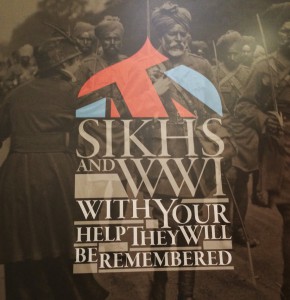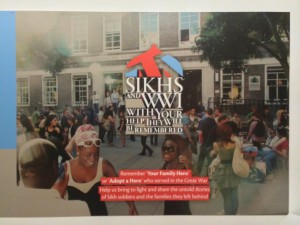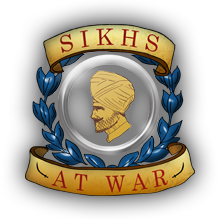Fifteen years, half of my lifetime thus far, have passed since I attended an event that stands out in shaping my self-confidence as a British Sikh. And in this review of the new exhibition “Empire, Faith and War” I must begin in the spring of 1999.
It was the tercentenary of the birth of the Sikh brotherhood – the Khalsa; and as a teenager i was active with my schools Sikh society. I thought it would be a great idea to visit with fellow students a new exhibition everyone in my community was talking about. And so one Saturday with a teacher and a minibus eagerly arranged we embarked upon a trip from Birmingham to London.
The exhibition we visited was the groundbreaking “Arts of the Sikh Kingdom” at the prestigious V&A. It was the first time the jewels of the Sikh faith were on display and a rare event for a mainstream museum to be hosting a closer examination of the Sikhs.
As a band of young impressionable men (I went to a boys grammar school) we were moved by the treasures and history we saw before our eyes. I bought a copy of the inspirational “Warrior Saints” book with my pocket money, and it was from there that my desire to read and delve into Anglo-Sikh history and heritage began.
 Just like Amandeep Singh Madra and Parmjit Singh, who were featured in the BBC1 documentary series “The Sikhs” on Vaisakhi that year, I too wanted to write and research about Sikhs. I’d like to think as a mainstream journalist (and one who has produced independent projects alongside organizations such as the Arts Council, as well as events in prestigious venues such as Parliament and RMA Sandhurst) that that visit and iconic book sparked my drive to tell the Sikh story to mainstream audiences.
Just like Amandeep Singh Madra and Parmjit Singh, who were featured in the BBC1 documentary series “The Sikhs” on Vaisakhi that year, I too wanted to write and research about Sikhs. I’d like to think as a mainstream journalist (and one who has produced independent projects alongside organizations such as the Arts Council, as well as events in prestigious venues such as Parliament and RMA Sandhurst) that that visit and iconic book sparked my drive to tell the Sikh story to mainstream audiences.
These thoughts were at the forefront of my mind as I missed the launch of the “Empire Faith and War” exhibition in the Brunei Gallery at SOAS some weeks ago, due to a foreign work commitment. But on Thursday at the regular late night opening of the exhibit I finally made a visit with my family. And, to my secret delight, was given an introduction to the exhibition and project by the UKPHA Chairman Amandeep Singh Madra.
It might be awkward, as a researcher, to look upon someone else’s hard work and efforts on the very subject you both work on. But I felt no such discomfort, as what I found at the EFW exhibit, as an insider to the Sikh WW1 story, was yes familiar but nonetheless an immensely satisfying and highly produced revelation of the contribution of the Sikhs during the war effort.
Knowing the world of history and heritage, and having had many online exchanges with Amandeep, I was immediately struck by the depth of research and imagery the UKPHA team had uncovered. Many new images I had not seen before alongside new videos from the era.
It is a testament to their hard work and continuous effort to delve, find, preserve and promote these treasures of knowledge which would otherwise be hidden or little understood. And a sign of their dedication that since their work on the original “Warrior Saints” in 1999 the team has progressed to become, undoubtedly, the leaders in their field of researching and producing content on Anglo-Sikh history and heritage. Bravo!

The story of the WW1 Sikh contribution as told through the exhibit unfolds in a way that lends itself to fascination and interest – how could a minority community have paid such a heavy sacrifice during the war effort. Being just 1% of the Indian population at the time (I had gone with 2% but will now look to reexamine the figure) the Sikhs made up a disproportionate amount – 20% – of the British Indian Army.
The audience is taken on parallel journeys, quite literally with the early WW1 element running alongside another about the empire of Maharaja Ranjit Singh, to be given a fuller picture of how a community of warriors went from sworn enemies of the British to the staunchest of allies. The splendid and abundant Toor Collection makes up the bulk of the physical heritage on display of that period, from an extremely rare coin of the first Sikh kingdom to the Maharajas sword and shield. Yet it is the fascinating X-rays of the wounds Sikhs suffered during the war, graciously lent from the Royal Collection by Her Majesty, that one gets a truer sense of the scale of this exhibit – it is a phenomena in itself. No stone has been left unturned in narrating how the Sikhs contributed to the First World War and how they and their families back at home were affected. From the Western Front through to Mesopotamia via campaigns in Gallipoli, Jerusalem, East Africa… it all unravels to make sense of their sacrifice.
The exhibition is a journey every person (Sikh or non, history enthusiast or not) should undertake as we mark the First World War and seek ways of better understanding the various elements of the conflict and the people involved in it. In better understanding the Sikh story one get’s a real appreciation of how the community has got to where it has today, as crucial players in British society and economy.
Visiting with my family was memorable – my 16 month old ran around looking at the sights (exclaiming her favourite phrase “oh wow” whenever she saw something she liked) and it presented an opportunity to enthuse upon our next generation the importance of our history. I recommend others take their families too – and if you have any children or young relatives take them with you as it will no doubt shape their understanding and self-confidence as British Sikhs much in the same way the “Arts of the Sikh Kingdom” did for me when I was growing up.
It is too easy to be critical of such hard works, the only doubt expressed in my mind about the experience was on overhearing a tour guide stating an incorrect fact (on the composition of the 36th Sikhs) as well as the hanging question mark I had about the practical ways the Sikh code of conduct was enacted by the soldiers – which in itself requires more research and reading.
 But I must offer this critique for balance – that the space for the exhibit does not do it justice. I do not doubt that with a larger room better laid out the UKPHA team could fill it with more riches of our history and rather than offering what in places is a general introduction to elements of the Sikh effort (such as with the campaign outside of Europe) could present more depth. Perhaps that is their intention or desire as they continue this project over the next few years.
But I must offer this critique for balance – that the space for the exhibit does not do it justice. I do not doubt that with a larger room better laid out the UKPHA team could fill it with more riches of our history and rather than offering what in places is a general introduction to elements of the Sikh effort (such as with the campaign outside of Europe) could present more depth. Perhaps that is their intention or desire as they continue this project over the next few years.
Finally, I so wanted to take something away with me – in the form of a book – of their research and images on the WW1 Sikhs and the behind-the-scenes story of how they made such a wonderful exhibition happen. Perhaps this is something they are working on – I’d love to buy it. There were books on sale, but some of these have been a turn-off for me because of the connection they’ve had with the sanatanist Nidar Singh. Though that should not in any way impact upon the view of UKPHA as the pioneers of bringing Anglo-Sikh heritage to the masses.
I do not doubt that, like me many years ago, there are many many more young impressionable men and women out there yearning for this power of knowledge – who inspired by such national events will progress the cause of the British Sikh community. They should see this exhibition and be proud of their communities heroism during the war – and of the awesome work of UKPHA in keeping their story alive.
******************
‘Empire, Faith & War’ is a project of the UK Punjab Heritage Association (UKPHA) and is supported by the Heritage Lottery Fund (HLF).
Learn more here: www.empirefaithwar.com and follow them on Twitter via @gt1588
 Just like Amandeep Singh Madra and Parmjit Singh, who were featured in the BBC1 documentary series “The Sikhs” on Vaisakhi that year, I too wanted to write and research about Sikhs. I’d like to think as a mainstream journalist (and one who has produced independent projects alongside organizations such as the Arts Council, as well as events in prestigious venues such as Parliament and RMA Sandhurst) that that visit and iconic book sparked my drive to tell the Sikh story to mainstream audiences.
Just like Amandeep Singh Madra and Parmjit Singh, who were featured in the BBC1 documentary series “The Sikhs” on Vaisakhi that year, I too wanted to write and research about Sikhs. I’d like to think as a mainstream journalist (and one who has produced independent projects alongside organizations such as the Arts Council, as well as events in prestigious venues such as Parliament and RMA Sandhurst) that that visit and iconic book sparked my drive to tell the Sikh story to mainstream audiences.  But I must offer this critique for balance – that the space for the exhibit does not do it justice. I do not doubt that with a larger room better laid out the UKPHA team could fill it with more riches of our history and rather than offering what in places is a general introduction to elements of the Sikh effort (such as with the campaign outside of Europe) could present more depth. Perhaps that is their intention or desire as they continue this project over the next few years.
But I must offer this critique for balance – that the space for the exhibit does not do it justice. I do not doubt that with a larger room better laid out the UKPHA team could fill it with more riches of our history and rather than offering what in places is a general introduction to elements of the Sikh effort (such as with the campaign outside of Europe) could present more depth. Perhaps that is their intention or desire as they continue this project over the next few years.


